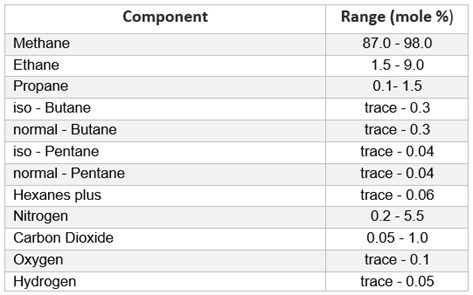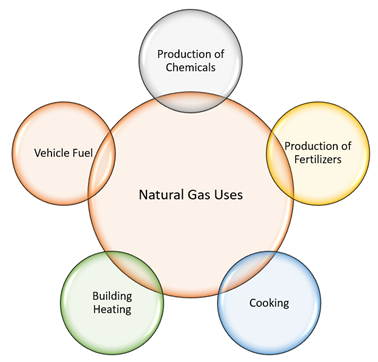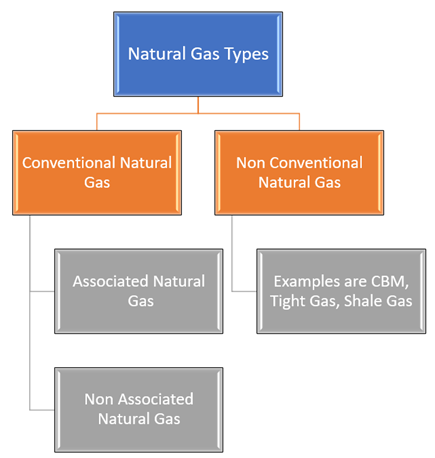Definition
Related Definitions
Natural Gas
Natural gas is a naturally occurring hydrocarbon gas that mainly contains methane with varying content of higher hydrocarbon chains and small quantities of nitrogen, carbon dioxide, helium and hydrogen sulphide. It can be found in the gaseous phase or in a solution form mixed with crude oil in underground reservoirs. Natural gas stays in the gaseous phase at atmospheric pressure and temperature.
Composition of Natural Gas:
It is difficult to show the exact composition of Natural Gas because the composition of gas depends on various factors like the source material, maturity, pressure and temperature of formation properties of reservoir rocks holding the gas. However, methane is the main constituent of Natural Gas, and a general estimate of the constituents of the natural gas can be seen as follows:

Copyright © 2021 Kalkine Media Pty Ltd
Use of Natural Gas:
Natural gas has a wide range of application. Let's glance at few most powerful applications of Natural gas:

Copyright © 2021 Kalkine Media Pty Ltd
- Natural gas is used in power plants for the generation of electricity.
- It is used in the industrial sector for heating purposes and feedstock to produce fertilizers and chemicals.
- It is used in residential purposes for cooking and heating buildings.
How is Natural Gas Formed?
Natural gas is formed by the decomposition of organic matter, which is typically formed from plants and animals' dead remains and get deposited over millions of years. The organic matter mixes up with sediments and gets deposited into the thick layers of the earth's surface on the ocean floor. The layers get buried under sand, silt and rocks. These layers get subsided with the deposition of new layers over time. The pressure and increased temperature due to subsidence change the organic matter into compounds of carbon and hydrogen. Some of the material gets converted into coal; some get converted to oil, and others in natural gas.
Types of Natural Gas:
On a broader scale, natural gas can be classified as Conventional and Non-Conventional based on the origin of the gas. Conventional natural gas can be extracted to the surface from the reservoirs using conventional drilling methods. The natural gas flows through the conventional vertical wellbores, including oil wells, gas wells or condensate wells.

Copyright © 2021 Kalkine Media Pty Ltd
Whereas unconventional or non-conventional natural gas can't be extracted using the conventional techniques of exploration. It requires the application of advanced exploration techniques to bring it to the surface. Unconventional reservoirs have very little permeability than conventional reservoirs, making it difficult for gas movement, restricting the readiness to flow into the wellbore. Tight gas, shale gas, coal methane, and gas hydrates are examples of non-conventional gas.
Advanced drilling techniques like horizontal drilling and hydrofracturing are used to introduce fractures into the reservoir to increase the reservoir's permeability so that gas can flow easily into the wellbore. Horizontal drilling provides extra coverage to the well for production.
On further classification, conventional natural gas sources can be categorized into two main types, viz. associated and non-associated natural gas. Associated natural is produced from crude oil wells. This type of gas is found in associated form with the production of crude oil. The gas exists in separated or mixed form into the reservoir. Another category of conventional natural gas is Non-Associated Gas which is found purely in gas wells or condensate wells, containing very little or no crude oil. This gas is not associated with crude oil and its production; hence, classified as Non-Associated Natural Gas.
How are Natural Gas reservoirs traced?
The hunt for natural gas reservoirs begins with the search for geological formations containing natural gas deposits. Geologists who study the process and structure of the earth demarcates the most likely regions that can withhold the natural gas deposits.
The geoscientists use various type of geophysical surveys to delineate the subsurface gas deposits. These surveys are undertaken in both onshore and offshore probable locations to get deeper information about the subsurface gas reservoirs. Scientists often use a seismic survey to delineate the shape, size and extent of the reservoir so that proper planning for the drilling of a well can be done if the area contains good prospects of having a gas deposit.
If the survey results are encouraging, an exploratory well is planned to test the reservoir. The testing results provide more detailed information about the quantity and quality of reserves present in the reservoir. Based on estimates and economic assessment, if the operating company finds the drilling to be commercially viable, further drilling occurs or else the operator drops the drilling plan.
However, the decision to drill depends on various factors like the type of reservoir, formation types, complexity of formation, location of proposed well, the trajectory of well and the estimated cost to drill the well. If all the conditions are in favour of drilling leading to commercial success, a well is drilled.
Natural Gas Processing and Consumption:
Natural Gas produced from a conventional oil or gas well is termed Wet Natural gas as it contains a significant amount of higher hydrocarbon. The methane content is relatively less compared to Dry Natural Gas. According to the USA classification scheme, wet gas must contain more than 0.1 Gallon condensates per 1000 cubic meter to be a wet gas.
After taking to the surface, the gas is sent for the primary processing, where natural gas is separated from water vapours and non-hydrocarbon compounds using a separator unit. The separated gas is also known as pipeline-quality natural gas. The separated or dry natural gas is then sent to underground storage reservoirs or distributed to the companies and then to the end-users.
Sometimes the associated natural gas is also used for reinjecting into oil reservoirs where the pipeline transportation facility is not available. The reinjection of gas into the reservoirs increases the reservoir's pressure and ultimately increases the production rate. Coal bed methane (CBM) can be removed from coal seams during mining and can be transported through gas pipelines without any special treatment.
